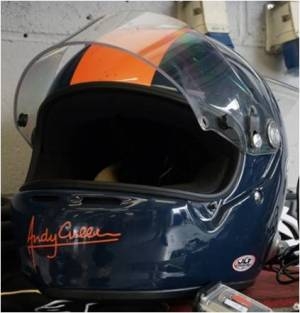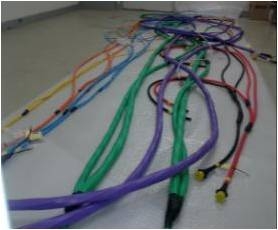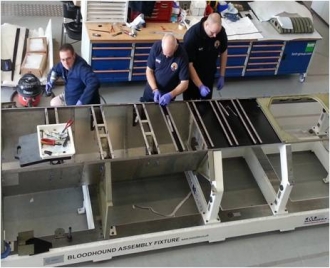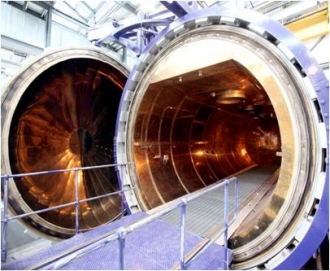
Project Bloodhound is about more than just building the world’s first 1000 mph Car (impressive though that will be). Our long-term legacy is the Bloodhound Education Programme, which continues to go from strength to strength. Our latest schools competition is the chance to design the colour scheme for my helmet. I’ve got 2 helmets so we’re going to pick 2 winners, one from the UK and one from South Africa. The winners will get a schools visit from Bloodhound, plus a chance to come and see the Car run for themselves. The competition closes on 10 May, so there’s still time to enter. if you’re quick.
The interest in South Africa is growing all the time. I was out there a few weeks ago, at the invitation of the British high Commission, to give one of the keynote presentations at ‘SciFest Africa’. The SciFest is a huge week-long education event which welcomed almost 70,000 visitors, and (not surprisingly) Bloodhound was a main attraction. As well as the keynote, one of my highlights was speaking at Ntsika township school. All of the kids – and a couple of journalists that joined us – were fascinated by the whole Project.

Ntsika Township School
 Nature helping the track preparation
Nature helping the track preparationWe’ve had some good news from the Hakskeen Pan recently – although it’s been a very dry rainy season, our track has finally flooded. After removing the old dirt causeway from the Pan, we really needed a good soak to complete the recuperation process, so the big dump of rain at the end of March was very welcome. I’m dying to see the effect on the surface, so I’m counting the days until it’s dry again. We’re lucky to have the help of a couple of South African soil experts, who are advising us and the Northern Cape Government on how to look after this beautiful natural surface when Bloodhound uses it. Our experts think that the Pan will be wet for several months yet, but I’ve got a bet with them that it will be dry before the end of June – I’ll let you know who wins.
Our engineering team in Bristol are hard at work, as usual. They sent me a picture of a rivet last week, which qualifies as the most boring photo update I’ve ever received. It was a significant event, though – after many weeks of fitting, drilling and treating all of the lower chassis components, they are now being fixed together permanently, and this was the first rivet of the final assembly.
 2.2 km of electric string
2.2 km of electric string
We’ve just received the first electrical wiring looms for the Car. With 3 engines to control and hundreds of sensors to monitor, there’s going to be a lot of wiring required. The looms will be installed as we go, so the first set will be fitted into the rear chassis as it’s assembled. Many thanks to Simon and the guys at DC Electronics for delivering so quickly last week, after putting a total of 2205.84 metres of wiring into the looms for us. That’s a lot of wire.....
Last weekend we had one of our regular briefings to our 1K Supporters’ Club. 120 people came to meet our team, see the work in progress and find out what we’re doing next. We even gave them a sneak preview of the forthcoming press announcement about our EJ200 jet engine – we’ve just had some very good news and I’ll tell you more next month! Part of the briefing went into detail on the lower chassis assembly, which was sitting in front of them. The lower chassis contains some 3000 rivets, which are strong enough by themselves to hold the structure together.
 Engineers with glue
Engineers with glue
The rivets will be reinforced by a bonding process (that’s engineering speak for gluing it together). The bonding will make the structure much stiffer, which will in turn raise its natural frequency. When the Car is tearing across the desert at high speed, a very stiff high-frequency structure is much less likely to react to the bumps and twists from the suspension, making it safer and easier for me to drive – so this bonding process gets my vote.
However, nothing is quite as simple as it seems. The chassis will be subjected to some fairly high temperatures when we run the jet and rocket engines, so the bonding agent needs to be a high-temperature glue. This means that it needs to be ‘cured’ at a high temperature – ideally 120°C. Unfortunately, as the rear chassis is made from a mixture of steel, aluminium and titanium, heating it up to 120°C is likely to cause it to buckle, as the metals expand at different rates. So here’s the question – can we use a lower temperature, around 80°C, to cure the glue?
Chris Hannon, one of our engineers, has been researching this problem. He’s tested dozens of bonded samples to check strength, heat resistance, etc. The easiest test is tensile strength – put a sample in a big machine and pull it until it fails. Next is ‘Differential Scanning Calorimetry’, which involves heating up a very small sample of the cured glue to see if has all set properly. If it isn’t fully set, then it will start to give off heat at some point, as the remainder of the glue sets, and this test measures the amount of heat released. Then there’s Dynamic Mechanical Analysis, which rapidly flexes a bonded sample as it’s heated up, to see when the glue starts to go soft. The results are all good – at 80°C, the bonding gives about 90% of the tensile strength, while the DSC test shows that the glue will be 90% set if we cure it for 13 hours at 80°C, after which it will start to go soft at about 85°C, instead of the usual 95°C.
 A really big oven
A really big oven
In simple terms, curing at 80°C will only lose us about 10% of the strength and heat resistance – and the remaining 90% is more than enough. At the end of this month, the whole lower chassis and assembly fixture will go into an autoclave (a really big oven) for 13 hours at 80°C. Then we can bolt it to the carbon fibre monocoque, giving us a joined-up chassis for the first time. I can’t wait to see it.
Finally, I’ve just seen the Virgin Media Business film, called ‘Breaking the Connectivity Barrier with Virgin Media Business’. It’s a lovely piece on how the new Virgin 1Gb fibre link lets us conduct video conferences with school classes. The video shows some rather striking school rocket cars and also features a clip of our lower chassis, so you can see what all the fuss is about. Enjoy!




